To Build A Wheel That Lasts, Test On Mars
9:13 minutes
The sound of a rover riding over a jagged Martian rock is similar to the racket of slowly crunching soda cans. How do we know? NASA engineers have rolled wheels across terrains similar to those that have been found on Mars.
At NASA Jet Propulsion Laboratory (JPL) in Pasadena, California, engineers have constructed an elaborate arena called the Mars Yard, a 21 by 22 meter sand lot filled with obstacles that simulate the Red Planet. This is all to test what makes the rover on the Mars2020 mission physically rove: the wheels.
JPL engineers Patrick DeGrosse and Chris Salvo are working to create rover wheels that can endure the diverse range of terrain on the Red Planet. SciFri visited JPL and witnessed the sights and sounds of rover wheel destruction.
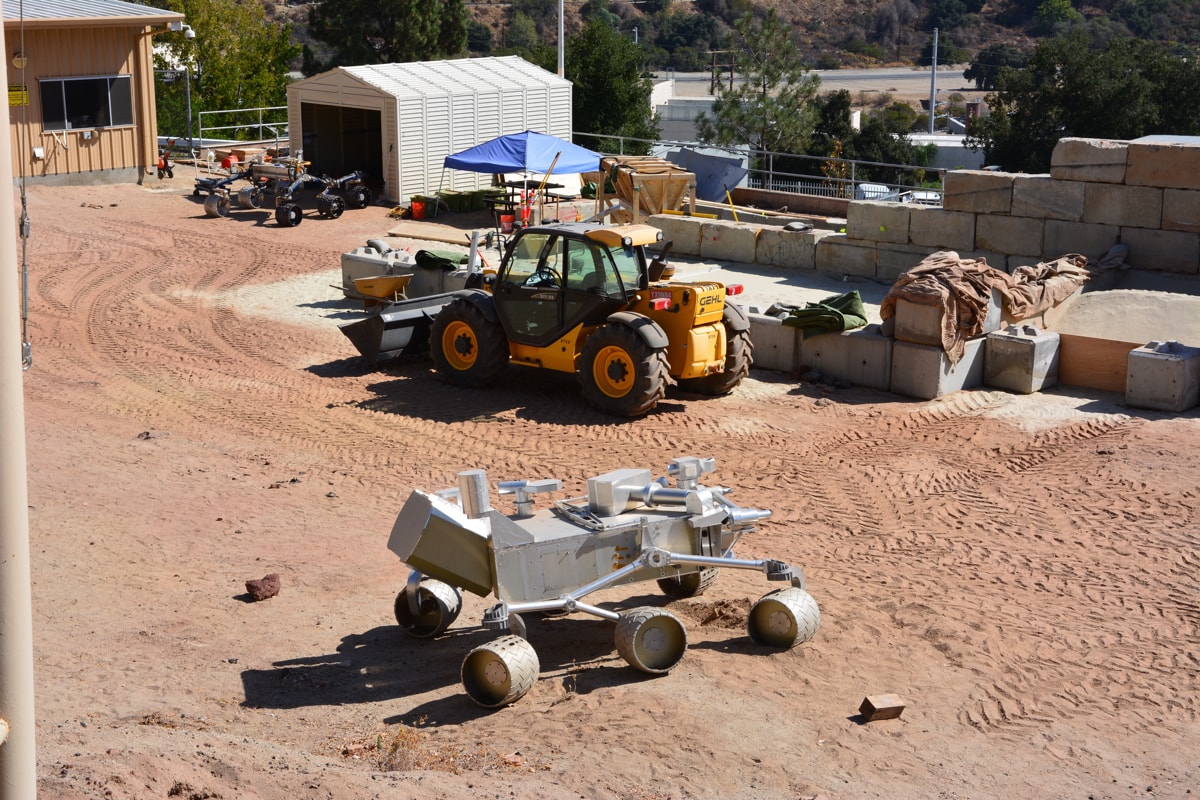
Before the next Mars rover launches in 2020 to hunt for evidence of past, microbial life, every little detail must be thoroughly tested, from the camera that takes pictures of the Martian landscape to the metal wheels that make everything go. Not any kind of wheel can be placed on a Mars rover. The semi-autonomous vehicle must have a set of rims that are not only lightweight for launch, but are durable and efficient enough to face the cold desert terrain of Mars.
[Try designing your own Mars rover wheel.]
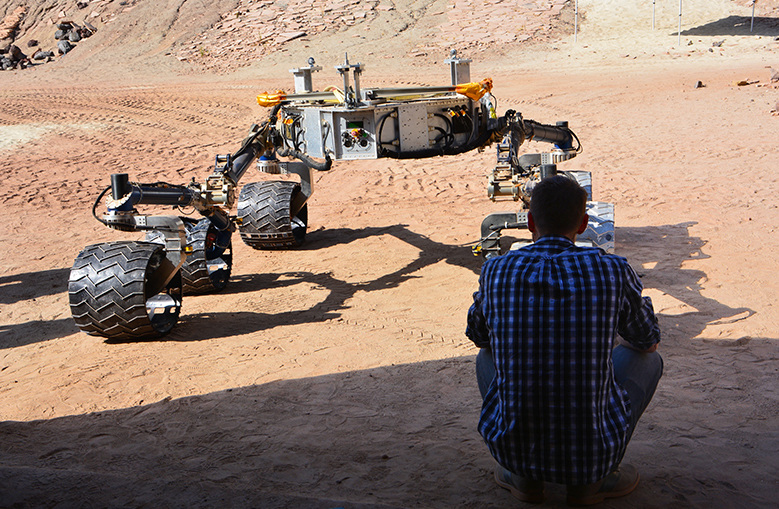
“We want to be able to tell [the operators] to drive over whatever they want up to the design height,” says Patrick DeGrosse, an engineer working on the Mars2020 mobility subsystem.
DeGrosse is a part of a specialized team assigned to design a better wheel for the Mars2020 rover. The engineers must try to think of every possible scenario these wheels might encounter on Mars, from roaming over sharp rocks to slipping in rippled sand dunes. In order to do that, they have simulated a Martian-type environment here on Earth. While the Mars Yard can’t mimic the iron-rich basalt sand or match the much denser stones found on the Red Planet, researchers have fashioned a series of obstacle courses of rocks, sand, slopes, and trenches to evaluate performance.

To test durability, the wheels take a spin on a carousel of torture—more technically known as the single-wheel test track—pictured above. The rig maneuvers a set of three wheels at 0.28 miles per hour (three times the speed of the actual rover) over a series of tiles of rocks.
At the Mars Yard, there is a rack of wheels that have been battered, dented, shredded into scraps, and “punctured to death.” The puncture wounds are meticulously labeled to help track down flaws in the design.
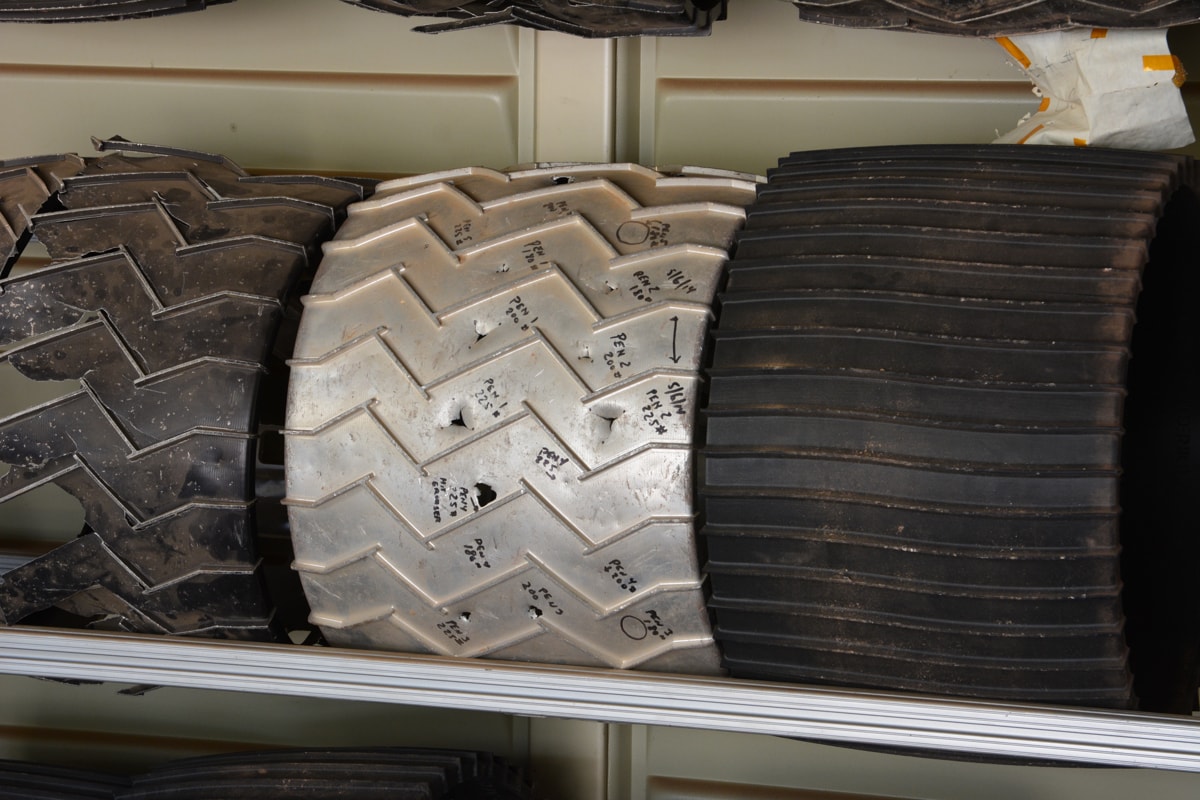
The zig-zag Chevron pattern of the grousers (the ridges on the wheel that help with traction) on the older models currently propelling Curiosity on its missions have rolled into some issues. In 2013, the rover operators noticed a gaping hole, which they named “Brutus,” in the left front wheel. After some investigation, they realized “it wasn’t just one little mishap that caused a puncture or one particularly awful rock,” says DeGrosse. “It was just the first symptom.”
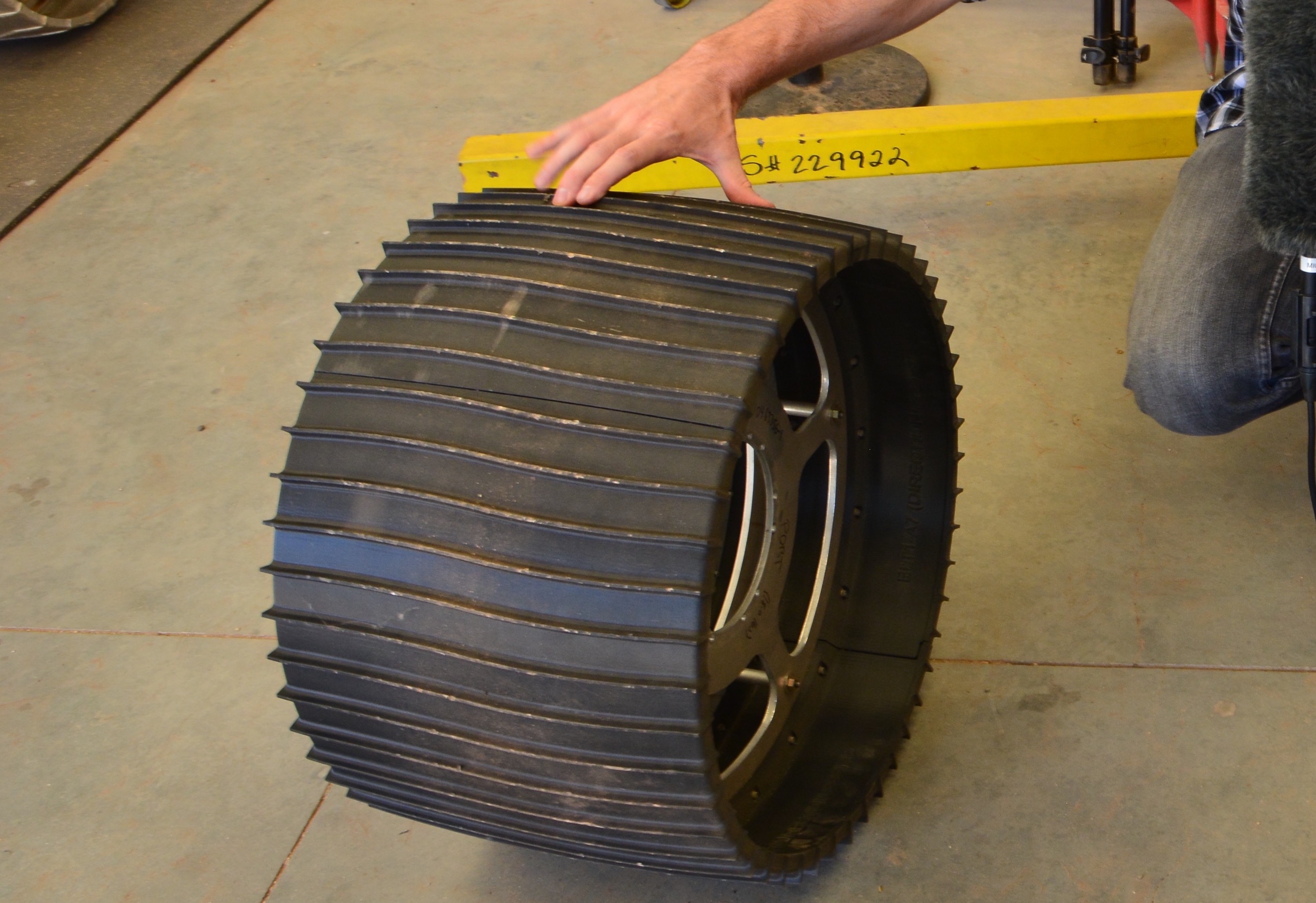
The wheels of Mars2020 rover will benefit from Curiosity’s battle wounds. So far, the engineers have created a design that is a little bigger in diameter, but narrower in width, and has a skin about two times thicker than Curiosity’s. But perhaps the most visible change is in the grousers. They are ten percent taller and run across the width of the wheel in a near straight line.
“It’s got a slight curvature to it to help give some strength to it,” says DeGrosse. As seen from the photos, the wheel is left almost unscathed at this point in testing.
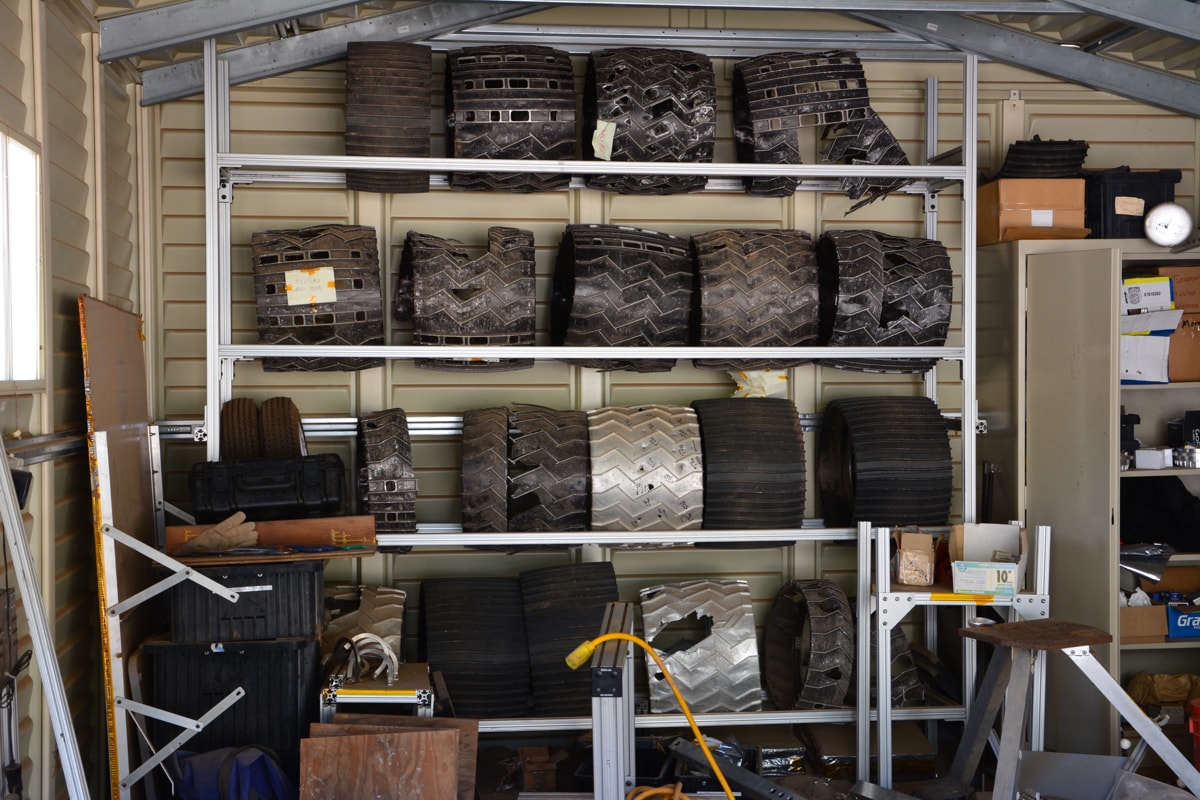
Many wheel prototypes may have been sacrificed, but it isn’t for naught. DeGrosse hopes the champion set of wheels will enable the Mars2020 rover to triumph over pointy rocks, soft sand, and other uncharted sites yet to be explored on Mars.
Patrick DeGrosse is an engineer at the NASA Jet Propulsion Laboratory in Pasadena, California.
Chris Salvo is an engineer at the NASA Jet Propulsion Laboratory in Pasadena, California.
Christie Taylor was a producer for Science Friday. Her days involved diligent research, too many phone calls for an introvert, and asking scientists if they have any audio of that narwhal heartbeat.
IRA FLATOW: This is Science Friday. I’m Ira Flatow. Visit NASA’s Jet Propulsion Lab in Pasadena, California, and you expect to find scientists working to send robots to distant planets, moons, and Mars. What you might not expect to find is robotic torture, dismemberment, or robot sadism. Science Friday’s Christie Taylor paid a visit and met engineers working hard on the Mars 2020 Rover mission. And she reports back on one component, very vital component, the wheels that keep it all rolling.
CHRISTIE TAYLOR: This story actually starts with Curiosity, the six-wheeled rover crawling across the red planet like a slow moving dune buggy. It’s October, 2013. It’s been exploring for 411 sols, or Martian days. That’s about 14 months. And it’s rolling slowly towards the foothills of Mount Sharp, where the sediments may reveal 2 billion years worth of Martian history.
And then a photo shows something foreboding. A hole in the left front wheel. By November, more holes appeared. And they got bigger, inches across in places. So NASA called in the engineering equivalent of the cavalry. A rapid response team called a tiger team.
It was a tiger team that helped see the Apollo 13 Lander safely back to Earth in 1970. In 2013, this tiger team’s job was to find out why the wheels were breaking and whether these holes would stop Curiosity’s mission in its tracks. Patrick Degrosse was one of the tigers.
PATRICK DEGROSSE: It’s my job to design, qualify, and deliver the suspension, the wheels, the differential, everything that makes the rover rove around Mars.
CHRISTIE TAYLOR: Degrosse’s mission? Test copies of Curiosity’s wheels here on Earth on simulated Mars terrain to see how long they last and to see whether Curiosity could finish its 20 kilometer trek to its science targets.
Now, you might think it doesn’t take much engineering to build a wheel. We solved this thousands of years ago, right? But for a planet where the nighttime temperature dips below negative 275 degrees Fahrenheit, where you can’t send a mechanic at the slightest glitch, it takes a wheel unlike anything found on Earth.
PATRICK DEGROSSE: Using things like rubber where there’s glass transition temperatures to contend with isn’t an option for us.
CHRISTIE TAYLOR: What is a glass transition?
PATRICK DEGROSSE: So you ever take like a bouncy ball or see an experiment with a bouncy ball that goes into liquid nitrogen? And then you throw it on the ground and it no longer bounces. It shatters into a million pieces. That’s because it has crossed its glass transition temperature.
CHRISTIE TAYLOR: That’s what would happen to rubber tires on Mars. So Mars rovers need something different, some other material. But the wheels need to be as light as possible also, just like everything else we shoot into space. So we build them from aluminum and super thin. Just four times as thick as a Coke can.
Another reason these wheels are different? They also double as landing gear for the sky crane assisted descent to Martian soil. Once in their life, these wheels have to absorb 17,000 pounds of impact. They do it with the right aluminum alloy, supportive spokes, and a few other engineering tricks, which brings us back to that first big hole in Curiosity’s wheel.
How did it get there if this thing’s made of such strong metal? Patrick takes me to a nondescript shed that’s actually a graveyard or maybe catacombs for rover wheels. Shelves full of them, all looking like they’d been torn apart by a giant can opener or poked repeatedly with a knife.
PATRICK DEGROSSE: This wheel that’s up on the top in the center here, this one saw a single wheel test track for most of its life. And it’s essentially punctured to death.
CHRISTIE TAYLOR: Some of the test wheels Patrick shows me are torn nearly down the middle, ripped like a piece of tissue paper right where the spokes meet the wheel. This is from metal fatigue as the wheel flexed in tiny repetitions over long periods of time. Other wheels were repeatedly punctured by rocks and are now peppered with holes.
These wheels are all examples of what could happen to Curiosity on different kinds of Martian terrain after months and kilometers of different tests. And where Patrick takes me next is ground zero for testing those rover wheels here on Earth. A sandbox for robots with a lot of rocks thrown in for fun.
PATRICK DEGROSSE: So we’re standing out here on the observation deck of JPL’s MarsYard.
CHRISTIE TAYLOR: It’s like a big, dusty football field with a few different slopes, flat, smooth flagstones like you might see in landscaping, sharp rocks, big rocks, sand, and dust. My shoes and microphone cords will come home covered in a fine layer of silt. And then up the hill, there’s another test space. A round ring like a kid’s pony ride that a set of three wheels traverse over and over, circles upon circles at less than a third of a mile per hour.
That awful sound is the wheels, grinding slowly over a smorgasbord of rocks, round, and round, and round for up to 60 kilometers. This torture track is the place where all those punctured rolling gladiators we saw earlier met their maker. Testing whether the wheels can go distance they would need to on Mars. Most of them couldn’t.
The good news is that even an awful, chewed-up looking wheel can still rove across Mars pretty well. Take Curiosity. Just last month, it’s snapped two raised treads on one wheel. Looks pretty gnarly, but it’s still rolling. It just has to be more selective about where it roves to get the most science done before the damage piles up. With 15 kilometers, it should easily finish out the mission goal of 20.
Meanwhile, Patrick has his eye on the next Mars mission, Mars 2020, already in development. He wants to give that rover a wheel that can drive over anything.
Back down in the MarsYard, a pared down version of a rover demonstrates how the Mars 2020’s wheels might behave. Does the rover slip going uphill, or bog down in sand, or stumble on a sharp piece of rock? And physics equations, they can’t tell you any of that. This test track, the MarsYard, is the only way to really understand this vehicle’s many tiny interactions with the physics of Mars.
CHRIS SALVO: You don’t sit down at your computer and draw up the complexity of sand grains, and rocks, and what all those friction coefficients are, and how they tumble over each other when a wheel hits them. We’re just not at that stage now.
CHRISTIE TAYLOR: That’s Chris Salvo, another engineer.
CHRIS SALVO: I’m the manager for the part of the project that delivers the stuff that looks like a rover.
CHRISTIE TAYLOR: The MarsYard is also a place to test weird new phenomena we’ve never before seen on Earth. Like what they’re building right now. It’s a dune field, but a type of sand dunes you’d never find on Earth today because we just don’t have the right wind and atmospheric conditions to drift sand around like that. These small repeating sand dunes, they’re are about a meter apart and known as ripples. They’ve been causing Curiosity to stall. Patrick Degrosse.
PATRICK DEGROSSE: It seems to be the thing that everyone on 2020’s surface planning team is a bit scared of.
CHRISTIE TAYLOR: Building and testing ripples here on Earth will bring us that much closer to a Mars 2020 wheel that can take anything the red planet throws at it. Here’s what else Patrick and his team have figured out for 2020. Rover wheels need a thicker skin. A whopping 0.006 of an inch instead of 0.003. As thick as a dime, even if that means more weight.
And they’ve also changed the layout of the spokes inside the wheels, reducing some of the forces that caused the wheels to fatigue down the middle. The treads are bigger and they’re using more modern forging techniques to shape the aluminum. Plus a few other tweaks that, I’ll be honest, are a bit too nerdy for radio. And all those tweaks will be tested more before lift off and as the whole rover comes together. Chris Salvo.
CHRIS SALVO: I’m personally looking forward to the centrifuge test. If you’ve seen any of those commercials where they put a pickup truck on a centrifuge and spin it around, that’s the test rig. So I’m looking forward to going out there and making our rover experience 18 Gs.
CHRISTIE TAYLOR: Do you sleep at night?
CHRIS SALVO: No. Not until it’s done.
CHRISTIE TAYLOR: After all the tests are done, Patrick, Chris, and the other engineers will have to say goodbye to the rover that’s still really just a twinkle in their eyes.
PATRICK DEGROSSE: We personify them. We have emotion about them. And we want to see them succeed. When this rover gets dropped on the surface of Mars, there’s definitely a bit of a heartache, a little loneliness that sets in because you won’t be able to see it again.
CHRISTIE TAYLOR: By that point, the Mars 2020 Rover will have a name. Hopefully, one as auspicious as Curiosity, Spirit, or Opportunity. And it will be hard at work, crawling across Mars, looking for signs of past microscopic life. And maybe, just maybe sending us postcards that reveal the first hints of life on another world.
With such a grand vision, it’s only fitting that we’d have to reinvent the wheel to get there. For Science Friday, I’m Christie Taylor.
IRA FLATOW: And if you want to look at the MarsYard, we have photos and more of that lovely grinding rover noise up on our website at sciencefriday.com/rover. Shout-out to our web producer Lauren Young for that great rover wheel gallery that is up there. Plus you can try to make your own rover wheels. Xochitl Garcia from our education team has a great activity you can try for reinventing wheels. And you can do that at sciencefriday– all of that, sciencefriday.com/wheels.
Copyright © 2017 Science Friday Initiative. All rights reserved. Science Friday transcripts are produced on a tight deadline by 3Play Media. Fidelity to the original aired/published audio or video file might vary, and text might be updated or amended in the future. For the authoritative record of ScienceFriday’s programming, please visit the original aired/published recording. For terms of use and more information, visit our policies pages at http://www.sciencefriday.com/about/policies/
Christie Taylor was a producer for Science Friday. Her days involved diligent research, too many phone calls for an introvert, and asking scientists if they have any audio of that narwhal heartbeat.
Lauren J. Young was Science Friday’s digital producer. When she’s not shelving books as a library assistant, she’s adding to her impressive Pez dispenser collection.